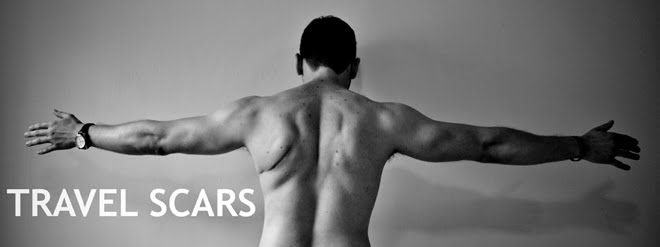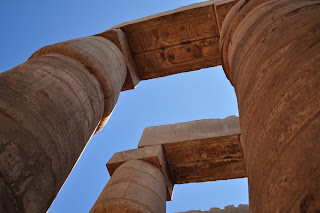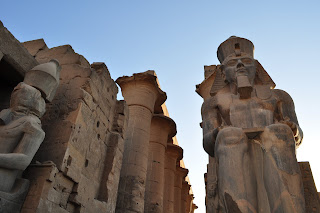Dec. 1st - 3rd
The 668 km overnight train ride passed without a hitch. We exited the train and stood on the platform as the scores of rush-hour travelers bumped into us and our cumbersome backpacks. We crowded near the wall and waited for our friend Ahmed, an Alexandrian who had also taken the Sudan-Egypt ferry from Wadi Halfa, to join us at this prearranged meeting place. We spent some time on the overcrowded terminal until Ahmed called and told us where to meet him. It was only a short time before Ahmed rushed over to greet us.

Alexandria, a sprawling city of 4.1-million people, welcomed us with its hectic atmosphere and cool sea air. A city far more modern and relatable to western culture than we had encountered in a very long time. Ahmed led us through crowded streets, pedestrian tunnels and on street cars in order to reach Alexandria's incredible corniche, the multi-lane road hugging Alexandria's portion of the Mediterranean sea.

We were now only a few blocks away, and as we made our final turn and saw the vast blue expanse of the Mediterranean, I couldn't help but smile. Chris and I exchanged the same high-five that we did after reaching every new country on our African adventure, only this one brought a twinge of sadness to me. Our arrival to the north of Egypt signified the near-completion of our incredible odyssey. As satisfying and fulfilling as it was to reach this point, I would have been just as happy to be staring at the Atlantic Ocean from South Africa's wonderful coastline, wondering what the following months would hold in store for us; as I had done six months earlier at the beginning of our trip. Reflecting on what I now knew and had experienced in order to reach this momentous occasion, brought back more incredible memories than could ever be contained within even the mighty sea which stood before us.

I soon snapped back into reality and we hailed a microbus. It drove speedily down the corniche, and dropped us off in an impressive looking district. Ahmed suggested we find a hotel in the area and after asking around, we soon found one that fit our budget. We dropped off our bags and washed off the filth that had accumulated after our 16-hour train-ride.
Our evening was rather low-key and consisted primarily of us eating shawarma, drinking tea and smoking shisha. We capped our evening off with two beers in our hotel room bought at a conveniently located liquor-store just around the corner from our hotel. We bid goodnight to Ahmed and called it a day.
The following morning, Ahmed reappeared and was prepared to give us a tour of his beloved city. We started off by grabbing a quick bite to eat before heading out. We explored the many neighborhoods leading to our first destination: the Roman Amphitheater of Alexandria.

Many of Alexandria's ancient relics, including the Lighthouse of Alexandria (Pharos), one of the 7 Wonders of the Ancient World, have been lost or destroyed due to the perpetual sieges, battles, attempted take-overs and natural disasters that have plagued this city since its foundation in 331 BC by its namesake, Alexander the Great. Today, much of the central core of Alexandria is brimming with buildings that resemble the architecture that can be found in cities such as Nice in France, or Granada in Spain. If it weren't for the subtle hints of Egyptian culture, you could easily imagine yourself in Europe.
Once at the Amphitheater, we took our time exploring the many corners of it. The entire archaeological site is flanked by modern apartment buildings and other contemporary structures.


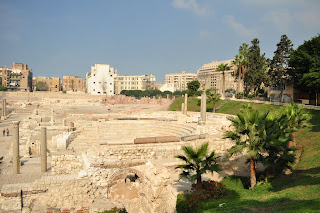
From there, we continued to old Alexandria and saw Pompey's Pillar from outside the gates. This structure served as a Roman triumphal column, commemorating the victory of Roman Emperor Diocletian. We opted not to pay to go see it and were content with our obstructed yet still relatively clear view of the immense monolithic structure. Not too far from here, we passed the Kom el-Shoqafa, or Alexandrian catacombs, considered by some to be one of the 7 Medieval Wonders of the World. Once again, we opted to forgo entry and continue our walking tour of the city.

We continued to follow Ahmed through the city streets as he explained the socioeconomic aspects of Alexandria. Before we knew it, we were walking in a less-than-impressive part of town. The streets were littered with trinkets, knick knacks and every conceivable second-hand item you could think of. We finally found ourselves in front of the port of Alexandria, not the picturesque, historic one along the corniche, but the actual industrial seaport used for importation and exportation of cargo and goods. Although Ahmed would probably not admit it, I'm pretty sure he had just gotten lost!
After talking to some taxi drivers, we were directed back towards the center of the city. We walked along the corniche, ate some koshary, a delicious and inexpensive Egyptian dish consisting of macaroni, lentils and spicy tomato sauce. We watched the sun set over the Mediterranean and then walked to the fortress of Kait Bey to grab some surprisingly good ice cream. Our evening was spent much like the night before, consisting of more tea, and more shisha. Despite the cosmopolitan, European vibe emanating from Alexandria, we were still hard-pressed to find any signs of the vibrant night-life that we expected from this fashionable, vibrant city.
Ahmed was a member of Cycle Egypt (www.cycle-egypt.com), a non-profit organization that provides bicycles for hundreds of people interested in taking regular bike rides throughout Alexandria. We had gone with Ahmed to register our names, because it just so happened that there would be a ride on our last day in Alex. For a small fee, you show up at a meeting place and are provided with an impressive bike to ride for a few hours.

We took a microbus to the rendezvous point and were joined by a hundred or more Egyptian youth and one or two other foreigners. Ahmed introduced us to some of his friends in the group, and before we knew it, a few flat-bed trucks arrived and dropped off the bikes. We each received our bikes and waited to start our ride.

Today's ride started several kilometers from our hotel and would terminate in front of Alexandria's famous Bibliotheca Alexandrina or the new Library of Alexandria. We would be riding along the corniche, in the lane closest to the sidewalk. The ride provided a really unique view of the city, and with Alex's beautiful architecture to our left and the Mediterranean to our right, it made for a really terrific morning. Although I'm not sure of the status of the corniche in regards to speed limit; the fact that cars, buses and motorcycles use it much like we use an expressway, added a certain degree of excitement (or fear depending on the way you look at it), as they passed next to us going in excess of 70 km per hour.

As I had mentioned, the ride ended in front of the Bibliotheca Alexandrina. This library is a modern resurrection and commemoration of Alexandria's ancient library that was lost in antiquity. It was a futuristic looking building to say the least. We took some photos of it and Egypt's very own Death Star before continuing along the corniche.
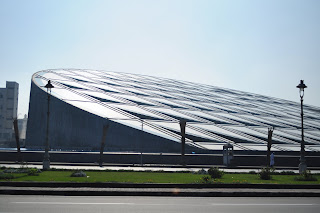


We took a brief break to wander around the grounds of the Abu al-Abbas al-Mursi Mosque and made our way to the Fortress of Kait Bey. The fortress had been built by the Mamelukes in 1480 to protect the city from an impending and consequently successful Ottoman invasion. It has recently been restored by the Egyptian Government after having been greatly damaged by a British Naval fleet in 1882, when the British seized Alexandria from the Turks.

Today the fortress is a place where local Alexandrians and tourists alike come to sit by the sea, eat ice cream or take hilarious boat rides. Chris and I sat by the water and enjoyed the maritime atmosphere, completely and deliberately oblivious to the men trying to sell us a variety of souvenirs.


Our final hours in this sea-side town were spent searching for a famous seafood restaurant, which we eventually found thanks to the tenacious efforts of Ahmed. The meal was quite possibly the second best seafood meal I have ever had, after the brass bell in Cape Town, South Africa of course. Funny how the alpha and omega of our trip revolves around delectable crustaceans and fish!

After dinner and a short walk, Ahmed helped us hail a cab that would take us to the bus station in order to catch our night-bus to the Siwa Oasis in western Egypt. Ahmed had been an incredible ambassador for his city. Yet again, another amazing person we had met along our voyage had given us a truly unique experience so often missed by most other travelers.
We were truly blessed.
